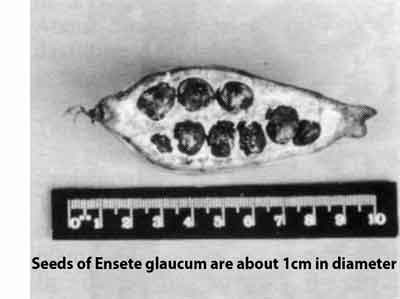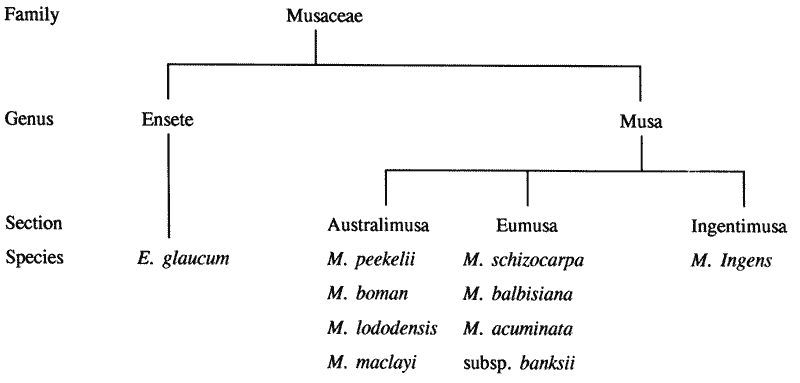
THE WILD BANANA SPECIES OF PAPUA NEW GUINEA
SCIENTIFIC NAME: Musa species
FAMILY: Musaceae
 During November 1988, I took part in a banana germplasm collecting mission to Papua New Guinea. Amongst the varieties seen and collected were 10 wild seeded species. These wild species are thought to be the ancestors of some of our cultivated varieties today. The large number of wild species and cultivars present in Papua New Guinea indicates it is a major centre of origin of bananas. The systematic position of the PNG species is shown in Figure 1. Two of the wild species in PNG also occur naturally in North Queensland - namely Musa acuminata subsp. banksii and Musa jackeyi (Musa maclayi subsp. ailuluai).
During November 1988, I took part in a banana germplasm collecting mission to Papua New Guinea. Amongst the varieties seen and collected were 10 wild seeded species. These wild species are thought to be the ancestors of some of our cultivated varieties today. The large number of wild species and cultivars present in Papua New Guinea indicates it is a major centre of origin of bananas. The systematic position of the PNG species is shown in Figure 1. Two of the wild species in PNG also occur naturally in North Queensland - namely Musa acuminata subsp. banksii and Musa jackeyi (Musa maclayi subsp. ailuluai).
Wild species of bananas are located throughout much of PNG and are often found in association with rainforests and streams. They come in an interesting array of forms and sizes including the giant Musa ingens (see 'Papua New Guinea - Land Of The Giant Banana, May 1992'), Musa maclayi with an upright bunch and red sap and the non-suckering Ensete glaucum with hard black seeds 1 cm in diameter, often used as beads in necklaces. Musa schizocarpa is quite interesting because the fruit skin peels itself back from the flower end upon ripening, so presenting an easy meal for feeding animals which help spread the seeds. Several of the wild species are very tall, with Musa ingens coming in at 18m, Musa peekelii, 6-7m, and Musa maclayi and Musa schizocarpa, 4-6m.
The fruit of these wild species is of little use for eating because they are full of hard seeds with very little pulp present. Leaves of some wild species such as Musa balbisiana are particularly good for wrapping food to be cooked, though many banana types are used for this purpose. Several of the wild species have resistance to the leaf diseases, yellow Sigatoka and black Sigatoka, and so should prove useful in breeding to develop resistant commercial varieties.
The collecting mission to Papua New Guinea was supported by the International Board for Plant Genetic Resources. This board is responsible for ensuring the conservation of valuable germplasm for the future. Papua New Guinea, as a major centre of diversity for bananas, has received special attention for such conservation.
Pest and disease threats to the commercial banana industry in Queensland such as black Sigatoka leaf disease present in Papua New Guinea means that strict quarantine must be enforced when banana varieties are being introduced, to ensure diseases do not enter and jeopardise our industry.
Figure l. Systematic Diagram of PNG Wild Species

DATE: September 1994
* * * * * * * * * * * * *
